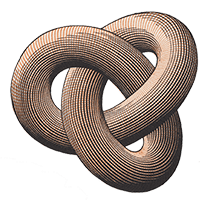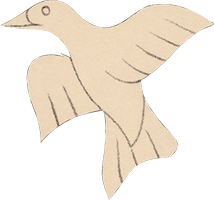Maura Biava
11 June to 15 September 2024
Maura Biava was the first artist to create underwater photography in the early 1990s. Accompanied by a photographer and a diver, she herself would dive metres deep into the sea with costumes and objects for a photo series or a video of her performance. Every minute she was supplied with air so that she could stay underwater for an hour. This method alone could be called magical.
At a young age, the Italian artist was curious about the world around her, a trait she shares with M.C. Escher. For her photography, drawings and ceramic work, she draws inspiration from nature and mathematics. In her solo exhibition at Escher in The Palace, she is showing three underwater photography works, new ceramic works and the resulting photography, as well as a series of works on paper.


Biava often used ceramic objects in recognisable natural forms such as stars, shells and flowers as props for her underwater photography. Gradually the objects became sculptures in their own right. For her presentation at Escher in The Palace, she is creating new ceramic work about hands, inspired by work by M.C. Escher. She sees her hands as an important source of energy, which she transforms into art using matter and a mathematical formula. The hands thus not only give form to the work of art, but also become the work itself. Also on display is a photo series featuring patterns of hands covered in clay, which Biava developed into wallpaper too.
As with Escher, for Maura Biava nature and mathematics are the basis for creating new worlds. While, for many people, mathematical principles are abstract and elusive, she tries to fathom and visualise them. Many forms, such as those of plants, humans and animals contain mathematical cores that also repeat themselves, like the star shapes in cacti and starfish, for example. This also occurs in man-made objects. For example, a star also forms the basis of soft, machine-served ice cream, which is thus nevertheless founded on natural principles.


For her Form Informed series of works on paper, Biava took analytical geometry as a starting point. Working with a mathematician, she converted mathematical formulae into graphs on paper. Using a computer programme, Biava combined two different formulae to obtain a new three-dimensional formula that is also visualised in the form of a graph. Her “palette of formulas” is broad: Biava combines the formulae of historically important mathematicians. For Form Informed, she gave the visual interpretations of two formulae their own colour, which she then printed on top of each other.
Maura Biava (b. 1970, Italy) was educated at the Liceo artistico in Brera and the Brera Academy in Milan (1992), and also attended the Rijksakademie in Amsterdam (1998). She has been artist in residence at EKWC in Den Bosch (2008) and at the ISCP, New York City, USA (2014). She is a specialist teacher at the Royal Academy in The Hague. Her work can be seen in exhibitions worldwide and features in several Dutch collections, including those of the Stedelijk Museum Amsterdam, Het Nieuwe Domein in Sittard and AkzoNobel Art Foundation.





